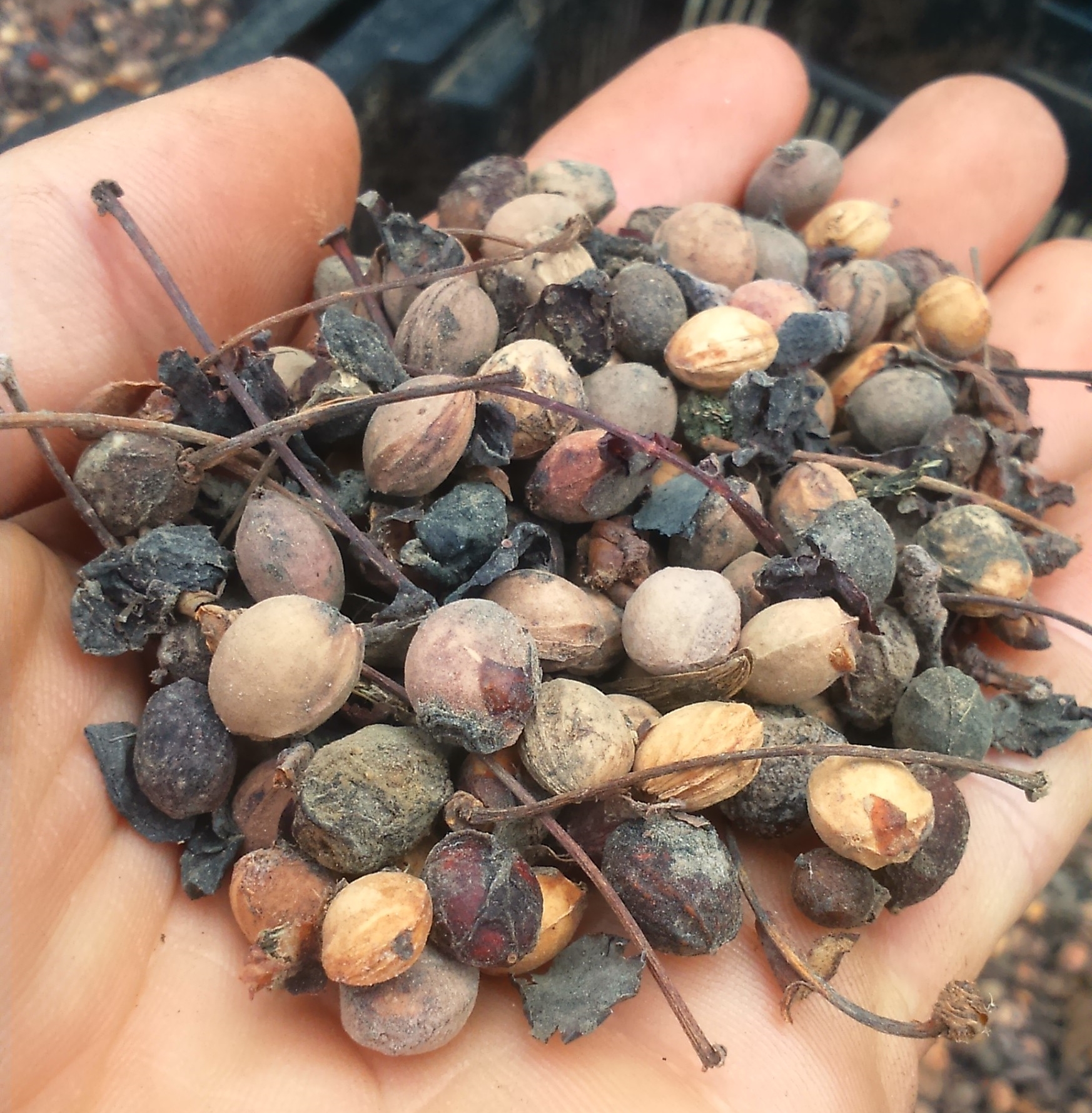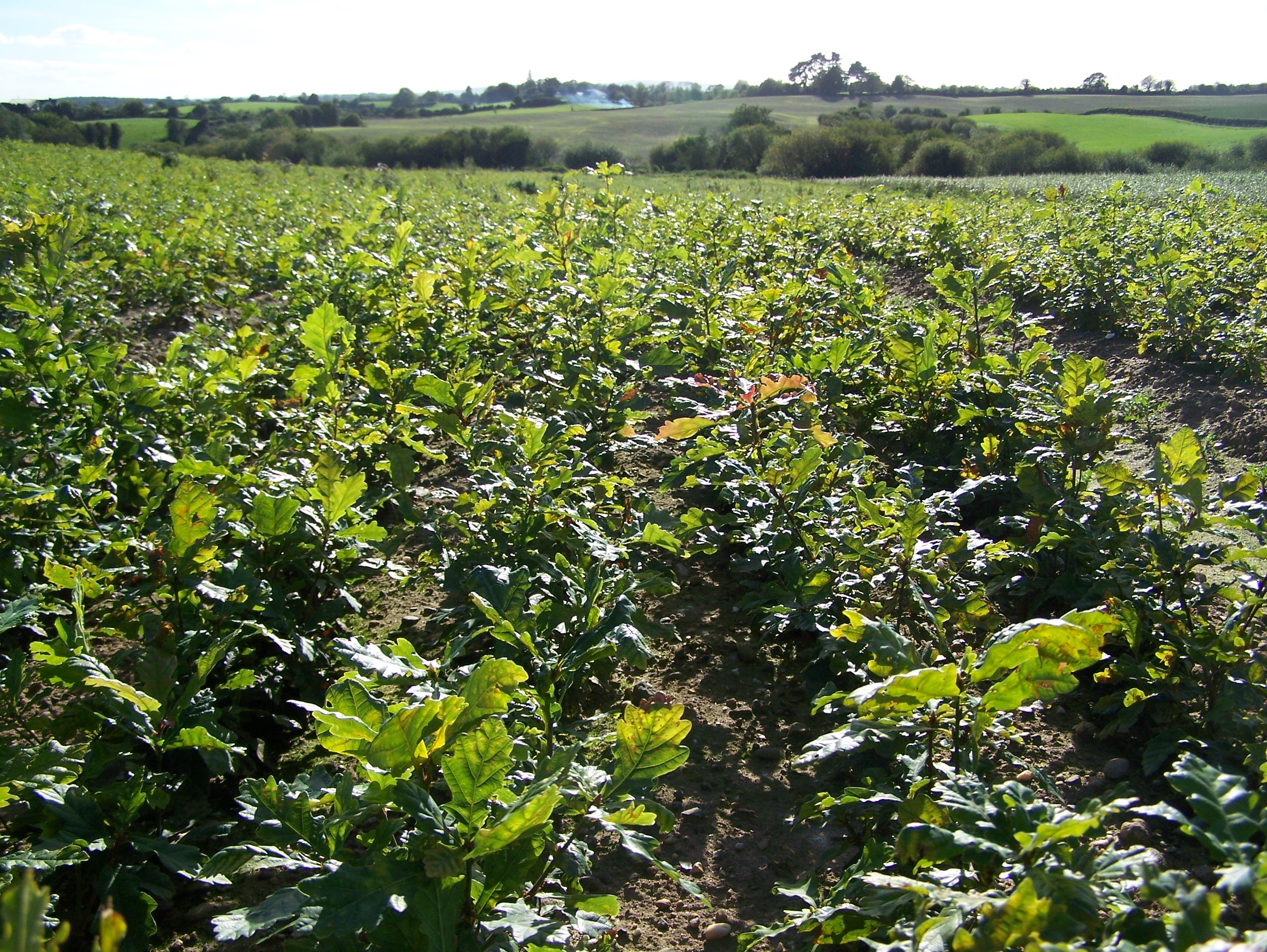Welcome to None-So-Hardy
Native Woodland Scheme
In None-So-Hardy Nurseries we take the long view
grow quality forests
Native Woodland Scheme
The Native Woodland Scheme is of increasing importance to the future of the afforestation programme. The most important species of this scheme is oak. A major obstacle to the development of the programme is the shortage of native oak stands. Tomnafinnogue Wood is the last surviving remnant of the famous Shillelagh woods in southern county Wicklow, and is situated near to our company base.
In September 2006 we surveyed, located and marked 100+ potentially good seed producing trees based on crown spread and area. The objective was to have an annual collection of acorns. We now observe these trees every August to project the likely crop for the autumn.
This collecting of native acorns is now a very important part of the nursery’s annual programme. This collection forms the basis of our native Oak supply and we need to maximise it every year to ensure a constant supply of native Oak seedlings. We also have earmarked other sites in Coollattin and Bunclody. We also now collect Whitethorn around our nursery. Rowan and Cherry are collected from Clonegal, Co Carlow and also some Hazel, Spindle and Guelder Rose in Co Clare.


Description of Native Woodland Scheme
The Native Woodland Scheme serves to protect, enhance and expand Ireland’s native woodland resource and its associated biodiversity. Once covering most of the island of Ireland surviving fragments of native woodland today comprise less than one percent of the country’s land area. Without active management and protection, this valuable part of our natural heritage will be lost forever.
The Native Woodlands Scheme is a grant package for landowners aimed at encouraging the proactive protection and expansion of Ireland’s native woodland resource and associated biodiversity, using appropriate “close to nature” silviculture.
The Native Woodlands Scheme has the potential to significantly reverse the decline of Ireland’s native woodlands and to secure a healthy, vibrant resource for future generations.
Some of the species Native to Ireland
- Ash
- Birches
- Bird Cherry
- Blackthorn
- Hawthorn
- Hazel
- Holly
- Pedunculate Oak
- Rowan
- Sessile Oak
- Whitethorn
- Wild Cherry


People often ask us questions about the Woodland Scheme and our methods and reasons for collecting seed. The information that follows will hopefully be helpful, instructive and interesting.
Why did we decide to take part in the NWS (Native Woodland Scheme)?
The Native Woodland Scheme is of increasing importance to the future of the afforestation programme. The most important species of this scheme is native Irish Oak. A major obstacle to the development of the programme is the shortage of native Oak stands. Irish Oak, unlike oak in some European countries (e.g. Holland), does not produce a significant crop of acorns on an annual basis.
We initially found it difficult to “catch up” on the demand, as the supplies of native acorns were not sufficient to meet the market. This was the initial inspiration for us to begin collecting our own seed. We are now in a position to stay ahead of the planting programme. However, to secure supply for any fallow years we intend to compensate by sowing for one and two year plants any time we gather a significant crop.

Where is the seed collected?
The seed is collected in Tomnafinnogue Wood. The wood is the last surviving remnant of the famous Shillelagh woods in southern county Wicklow and is situated near to our company base. Tomnafinnogue comprises some 66 hectares of mixed woodland, dominated by mature, single stemmed sessile Oak, and is a potentially important FRM (Forest Reproductive Material) source. We also have some good Hawthorn sites in Coollattin, Co Wicklow. Our Rowan and Cherry collection is mainly around Clonegal, Co Carlow. We also collect Hazel, Guelder Rose and Spindle in Co Clare.
What is needed in order to collect the seed?
In order to begin collecting the seed we needed two things:
- Permission from NPWS
- Permit from the Forest Service
Tomnafinnogue Wood is managed by National Parks and Wildlife Service. Our local NPWS ranger Eamon Doran gave us permission to collect seed in the wood, he facilitates us extremely well and is very enthusiastic about the acorns being used in this way.
We received a permit from the Forest Service who supervise all our collections and ensure all the crops are recorded and certified. We would like to acknowledge the guidance we have received from the Forest Service. As we are new to the process of seed collection it is helpful to have them guide us through the procedures and requirements for the marketing of Forest Reproductive Material.
What Species are collected?
Originally when we began the process our main aim as outlined above was to collect acorns from Irish Oak trees both Sessile (Quercus Petraea) and Pedunculate (Quercus Robur) Oak.
Apart from the collection of acorns we also collect other seeds which are included in the Native Woodland and FEPS / REPS schemes. These include Rowan, Hazel, Blackthorn, Whitethorn and Crab Apple. We have now extended our seed collection to include Holly, Guelder Rose and Spindle.
How are the trees identified as being possible good seed producers?
With the collection of acorns from Irish Oak trees, the trees are surveyed from the end of August to check for acorns. This involves walking around the woods with binoculars and looking for small undeveloped acorns in the branches. This can be quite difficult as the branches are so high up and its not until the acorns swell up in the beginning of September that we have any indication of that year’s potential.
When is the seed collected?
The seed is gathered during the weeks of September and October (approx. 8 weeks).
This involves placing nets below the trees to gather the seed and also hand picking the seed from the ground. It can be difficult to put down the nets in some areas due to undergrowth etc. so being able to hand pick the seed from these areas is vital to a successful seed collection.
We have found by experience that having our nets in place early is a key factor in increasing our collection. It is vital that we have the nets in place before any seed begins to fall. Also we have increased our number of pickers who are all kept busy during the weeks of September and October.
What happens to the seed once collected?
The seed is brought back to our base in Shillelagh to let it dry which involves spreading it out on the clean, rodent-free floor in the shed. Once the seed is ready it is sent to our nursery in Ballymurn to be sown.
What were the obstacles faced?
The main obstacles that we faced when gathering the seed were:
- Access to the seed – undergrowth in the wood proved to be a big obstacle regarding placing the nets, as in some places all the seed had to be hand picked as no net could be laid.
- Wild Animals – Deer, squirrels, pheasants etc. eating the seed proved to be another problem. If the sites are not closely monitored these animals will over time completely strip a site. Visiting the sites more frequently and taking what seed had gathered helped to somewhat improve our collection.
Our aims for the future of our seed collecting
We aim to provide customers with a two-year old native Irish Oak plant between 50 to 80 cm tall as opposed to a one-year old plant 30 to 50 cm tall which have been the norm for these native plants. These plants were necessary as demand dictated that we had to sell our one-year old plants each year to keep the programme going. This had a knock on effect as it meant we couldn’t grow the plants for another year, which would be the ideal situation.
Apart from fulfilling an obvious demand for plants it also gives us a deeper insight into the requirements for growing these plants and helps us form a better understanding of these species. It is also very interesting and rewarding seeing plants going out the gate grown from seed which have been nurtured to this stage right from their initial stage as fruit on the tree.
For further information on the collection of seed, click on the following link: http://www.coford.ie/



